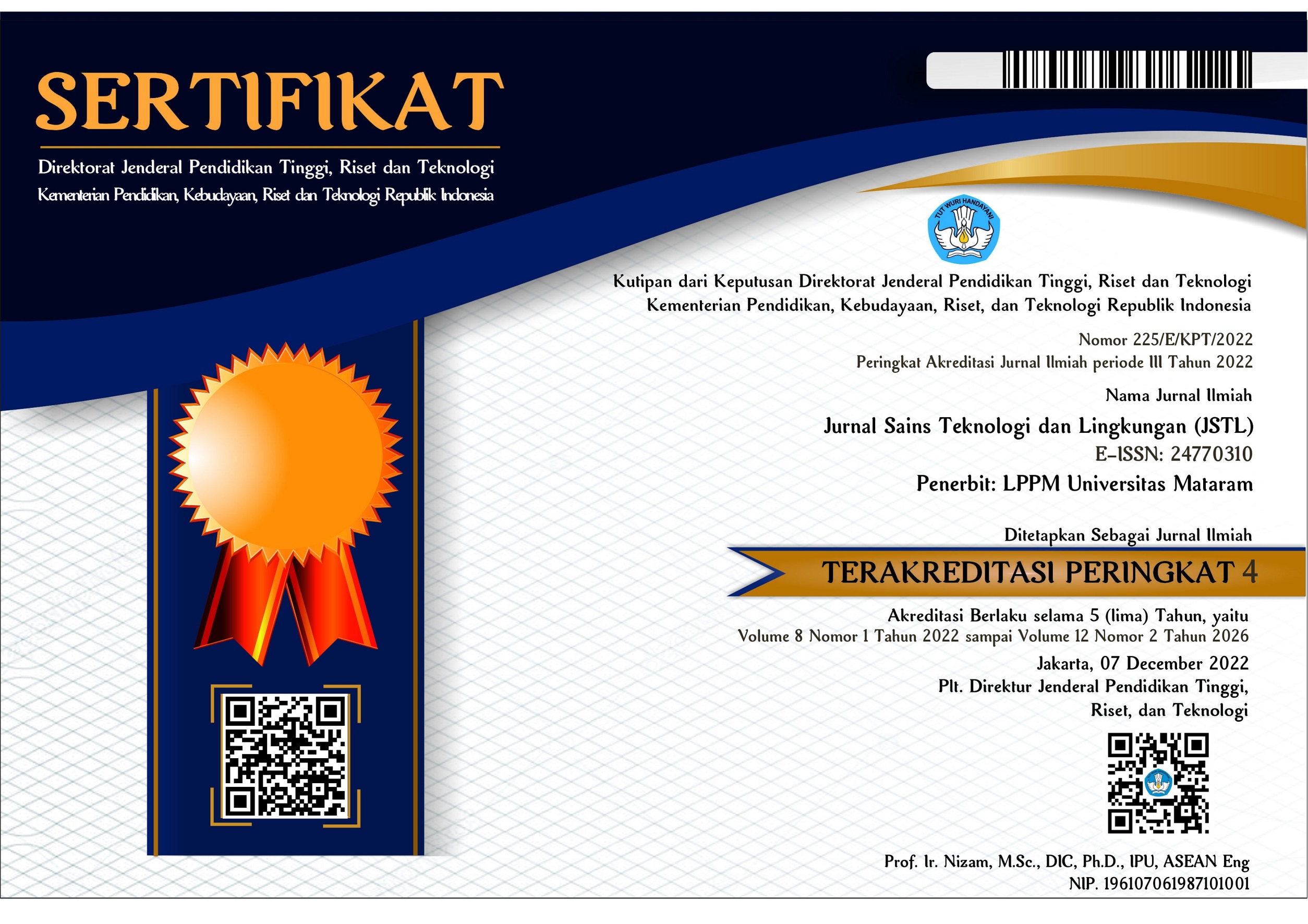Model Matematik Prediksi Pembentukan Biogas dari Limbah Kotoran Ternak
DOI:
https://doi.org/10.29303/jstl.v10i1.591Abstract
Petroleum is currently the most commonly used fuel in Indonesia, but its availability is decreasing! Therefore, alternative energy sources are needed. One solution is to convert agricultural and livestock waste into biogas, which is a renewable and environmentally friendly energy source! Biogas can be used for cooking, generating electricity, and even as fuel for vehicles! The aim of this research is to develop a mathematical model for predicting biogas volume! Can you believe it? The experiment involved creating biogas from a mixture of cow dung and water in a 1:2 ratio. The mixture was stirred until evenly distributed in a portable biogas floating drum. No gas was formed from the first day until the seventh day, but on the eighth day, gas began to form and its volume was recorded! A mathematical model approach, namely the Gompertz and Logistic Models, was used to predict the formation of biogas volume! And guess what? The results indicate that both models were able to predict the data accurately with a coefficient of determination (R2) of 0.99! The validity test results show that the Gompertz model is the most reliable for making predictions! This is indicated by the bias value of 0.002, MSEP value of 0.000, and EI of 0.058. The validity test value is smaller than the validity test value obtained in the Logistic model, which is a bias value of 0.016, MSEP value of 0.005, and Ei value of 0.329.References
Aznan, M. F. N., Yasin, N. H. M., Mohd, N., & Takriff, M. S. (2022). Growth kinetics determination using different mathematical models for microalgae Characium sp. UKM1, Chlorella sp. UKM2 and Coelastrella sp. UKM4. ASM Science Journal, 17.
Bustomi, S., & Yulianti, M. (2013). Model Hubungan Tinggi dan Diameter Pohon Akasia (Acacia auriculiformis) Sebagai Penghasil Kayu Energi di Kabupaten Purwokerto Provinsi Jawa Tengah. Jurnal Penelitian Hutan Tanaman, 10(3), 155–160.
Fitria, R., & Luthfi, S. A. C. (2022). Optimalisasi Biogas Dari Kotoran Sapi Dengan Penambahan Bahan Organik Dari Limbah Pertanian dan Pasar. Agrisaintifika, 6(1).
Gunnerson, C., & Stuckey, D. (1986). Integrated resource recovery. Anaerobic digestion: principles and practices for biogas systems. The World Bank.
Herwanto, H. W., Widiyaningtyas, T., & Indriana, P. (2019). Penerapan Algoritme Linear Regression untuk Prediksi Hasil Panen Tanaman Padi. In JNTETI (Vol. 8, Issue 4).
Khaidir. (2016). Pengolahan Limbah Pertanian Sebagai Bahan Bakar Alternatif Agricultural Waste Processing As Alternative Fuels. Jurnal Agrium, 13(2), 63–68.
Ndruru, R. E., Situmorang, M., & Tarigan, G. (2014). Analisa Faktor-Faktor yang Mempengaruhi Hasil Produksi Padi di Deli Serdang. Saintia Matematika, 2(1), 71–83.
Putra, G. M. D., Abdullah, S. H., Priyati, A., Setiawati, D. A., & Muttalib, S. A. (2017). Rancang Bangun Reaktor Biogas Tipe Portable Dari Kotoran Ternak Sapi. Jurnal Ilmiah Rekayasa Pertanian Dan Biosistem, 5(1).
Putra, G. M. D., Setiawati, D. A., & Murad. (2021). Study of mathematics modeling on ginger geometric changes during drying using image analysis. IOP Conference Series: Earth and Environmental Science, 733(1). https://doi.org/10.1088/1755-1315/733/1/012002
Rahmat, F. N. (2023). Analisis Pemanfaatan Sampah Organik Menjadi Energi Alternatif Biogas. Jurnal Energi Baru Dan Terbarukan, 4(2), 118–122. https://doi.org/10.14710/jebt.2023.16497
Rouf, A., Setiono, S., & Santosa, A. (2013). Urgensi Sensus Lilit Batang Sejak TBM 1 Sebagai Strategi Meningkatkan Keragaan dan Keseragaman Tanaman Karet. Warta Perkaretan, 32(2), 95–104.
Setiawati, D. A., Sutiarso, L., Ngadisih, N., Murtiningrum, M., Nugroho, A. P., Putra, G. M. D., & Chaer, M. S. I. (2023). Mathematic Modelling of Bok Choy Plant Canopy Area on Different Artificial Light at Plant Factory. Proceedings of the International Conference on Sustainable Environment, Agriculture and Tourism (ICOSEAT 2022), 26, 3–11. https://doi.org/10.2991/978-94-6463-086-2_2
Setiawati, D. A., Utomo, S. G., Murad, & Putra, G. M. D. (2021). Design of temperature and humidity control system on oyster mushroom plant house based on Internet of Things (IoT). IOP Conference Series: Earth and Environmental Science, 712(1). https://doi.org/10.1088/1755-1315/712/1/012002
Sulistiyanto, Y., Sustiyah, S., Zubaidah, S., & Satata, B. (2016). Pemanfatan Kotoran Sapi Sebagai Sumber Biogas Rumah Tangga di Kabupaten Pulang Pisau Provinsi Kalimantan Tengah. Jurnal Udayana Mengabdi, 15(2).
Supangat, A. B., Sudira, P., Supriyo, H., & Poedjirahajoe, E. (2018). Simulasi Model Dinamik Pengaruh Legume Cover Crops (LCC) Terhadap Limpasan dan Sedimen di Lahan Hutan Tanaman. Jurnal Penelitian Pengelolaan Daerah Aliran Sungai, 2(1), 17–34. https://doi.org/10.20886/jppdas.2018.2.1.17-34
Syamsuri, Suheni, Wulandari, Y., & Taufik. (2015). Analisa Performansi Kompor Biogas Dengan Volume Penampung Biogas 1 M3 Yang Dihasilkan Dari Reaktor Dengan Volume 5000 Liter. Seminar Nasional Sains Dan Teknologi Terapan III, 151–162.
Togelang, R. J., Rumbayan, M., & Mangindaan, G. (2022). Rancang Bangun Pembangkit Listrik Tenaga Biogas Skala Kecil Di Desa Kiama Talaud.
Downloads
Published
Issue
Section
License

This work is licensed under a Creative Commons Attribution-NonCommercial-ShareAlike 4.0 International License.


1.png)











